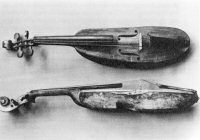| Music in Sweden 2 - Folk music | ||||
|
|
||||
|
Folk musicians and their music (1) |
|
|
|
|
|
Folk musicians and their music Peasant society had many musicians with a variety of instruments. These musicians were called "spelmän" (Sw. spelman; pl. spelmän), literally "playingmen". Their prime function was the accompaniment of pair-dances, but they also played at weddings, funerals and other ceremonies. "Spelmän" were as the name implies usually men, but female "spelmän" existed in some parts of Sweden.
A wellknown local variation is the clog-fiddle, fashioned from a wooden shoe, which is native to Sweden's most southern county, Skåne (= Scania). Most "spelmän" were not full-time musicians: they worked as farm-hands, soldiers and such or had small farms. Full-time "spelmän" did, however, exist in Skåne for instance one function of the governor of the county was to approve the "spelman" chosen by the farmers for their district: he had the sole right to play dance-music in that district. Some "spelmän" also played the organ in church: such "spelmän" could often read music. "Spelmansböcker" – books in which those able to read music wrote down their tunes – began to appear towards the end of the 17th century. The "spelman" who could read music was, however, an exception: mostly they learned the music by ear, mostly from older musicians, as do young folk musicians of today. |
|
Folk musicians and their music (1) |
|
|
|
|
|
|
||||
| Music in Sweden 2 - Folk music | ||||

 Clog
fiddle
Clog
fiddle